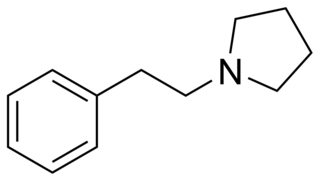MPPP or Desmethylprodine, 1-Methyl-4-phenyl-4-propionoxypiperidine, is an opioid drug.
MPPP may also refer to:
- MαPPP, or 4'-Methyl-α-pyrrolidinopropiophenone, a stimulant analog of α-PPP
- Multilink PPP, a communications technology
MPPP or Desmethylprodine, 1-Methyl-4-phenyl-4-propionoxypiperidine, is an opioid drug.
MPPP may also refer to:

MPTP (1-methyl-4-phenyl-1,2,3,6-tetrahydropyridine) is a chemical precursor to the neurotoxin MPP+, which causes permanent symptoms of Parkinson's disease by destroying dopaminergic neurons in the substantia nigra of the brain. It has been used to study disease models in various animal studies.

Desmethylprodine or 1-methyl-4-phenyl-4-propionoxypiperidine is an opioid analgesic drug developed in the 1940s by researchers at Hoffmann-La Roche. Desmethylprodine has been labeled by the DEA as a Schedule I drug in the United States. It is an analog of pethidine (meperidine) a Schedule II drug. Chemically, it is a reversed ester of pethidine which has about 70% of the potency of morphine. Unlike its derivative prodine, it was not reported to exhibit optical isomerism. It was reported to have 30 times the activity of pethidine and a greater analgesic effect than morphine in rats, and it was demonstrated to cause central nervous system stimulation in mice.

The Controlled Drugs and Substances Act is Canada's federal drug control statute. Passed in 1996 under Prime Minister Jean Chrétien's government, it repeals the Narcotic Control Act and Parts III and IV of the Food and Drugs Act, and establishes eight Schedules of controlled substances and two Classes of precursors. It provides that "The Governor in Council may, by order, amend any of Schedules I to VIII by adding to them or deleting from them any item or portion of an item, where the Governor in Council deems the amendment to be necessary in the public interest."

α-Pyrrolidinopropiophenone (α-PPP), is a stimulant drug. It is similar in structure to the appetite suppressant diethylpropion and has analogous effects in animals. Little is known about this compound, but it has been detected by laboratories in Germany as an ingredient in "ecstasy" tablets seized by law enforcement authorities. This drug has been found to produce stimulant effects in animals and presumably also produces these effects in humans, based on the context in which it has been found.

PEPAP (phenethylphenylacetoxypiperidine) is an opioid analgesic that is an analog of Desmethylprodine.

Phthalimidopropiophenone is a chemical intermediate used in the synthesis of cathinone. It has been found to be sold on the illicit market as a controlled substance analogue, but little is currently known about its pharmacology or toxicology.

3',4'-Methylenedioxy-α-pyrrolidinopropiophenone (MDPPP) is a stimulant designer drug. It was sold in Germany in the late 1990s and early 2000s as an ingredient in imitation ecstasy (MDMA) pills. It shares a similar chemical structure with α-PPP and MDPV, and has been shown to have reinforcing effects in rats.

4'-Methyl-α-pyrrolidinopropiophenone is a stimulant drug and substituted cathinone. It is structurally very similar to α-PPP, with only one added methyl group in the para position on the phenyl ring. 4-MePPP was sold in Germany as a designer drug in the late 1990s and early 2000s, along with a number of other pyrrolidinophenone derivatives. Although it has never achieved the same international popularity as its better-known relations α-PPP and MDPV, 4-MePPP is still sometimes found as an ingredient of grey-market "bath salt" blends such as "NRG-3".

4'-Methoxy-α-pyrrolidinopropiophenone (MOPPP) is a stimulant designer drug of the pyrrolidinophenone class. It has the potential to produce euphoria, an effect shared with other classical stimulants.

4'-Methyl-α-pyrrolidinohexiophenone (MPHP) is a stimulant compound which has been reported as a novel designer drug. It is closely related to pyrovalerone, being simply its chain-lengthened homologue. In the pyrrolidinophenone series, stimulant activity is maintained so long as the positions of the aryl, ketone and pyrrolidinyl groups are held constant, while the alkyl backbone can be varied anywhere between three and as many as seven carbons, with highest potency usually seen with the pentyl or isohexyl backbone, and a variety of substituents are tolerated on the aromatic ring.

α-Pyrrolidinobutiophenone (α-PBP) is a stimulant compound developed in the 1960s which has been reported as a novel designer drug. It can be thought of as the homologue lying between the two better known drugs α-PPP and α-PVP.

Pentylone is a stimulant developed in the 1960s. It is a substituted cathinone. It has been identified in some samples of powders sold as "NRG-1", along with varying blends of other cathinone derivatives including flephedrone, MDPBP, MDPV and 4-MePPP. It was also found in combination with 4-MePPP being sold as "NRG-3". Reports indicate side effects include feelings of paranoia, agitation and inability to sleep, with effects lasting for several days at high doses.
The molecular formula C14H21NO may refer to:

1-(2-Phenylethyl)pyrrolidine (PEP) is a chemical compound. It is an analogue of 2-phenylethylamine where the amine has been replaced by a pyrrolidine ring.

7-Methyl-α-ethyltryptamine (7-Me-αET) is a tryptamine derivative related to α-ethyltryptamine (αET). It was discovered by a team at Upjohn in the early 1960s. It has similar pharmacological effects to αET, but is both 3-4 times more potent as a serotonin releasing agent, and 10 times more potent as a monoamine oxidase inhibitor, making it potentially hazardous as this pharmacological profile is shared with drugs such as PMA and 4-MTA, which are known to be dangerous in humans when used at high doses.
Methylethyltryptamine may refer to:

Methylhydroxynandrolone, also known as 4-hydroxy-17α-methyl-19-nortestosterone (HMNT), as well as 4,17β-dihydroxy-17α-methylestr-4-en-3-one, is a synthetic, orally active anabolic–androgenic steroid (AAS) and a 17α-alkylated derivative of nandrolone (19-nortestosterone) which was never marketed. It was first described in 1964 and was studied in the treatment of breast cancer, but was not introduced for clinical use. The drug re-emerged in 2004 when it started being sold on the Internet as a "dietary supplement". MOHN joined other AAS as a controlled substance in the United States on 20 January 2005.

11β-Methyl-19-nortestosterone (11β-MNT) is a synthetic and orally active anabolic–androgenic steroid (AAS) and a derivative of nandrolone (19-nortestosterone) which was developed by the Contraceptive Development Branch (CDB) of the National Institute of Child Health and Human Development (NICHD) and has not been marketed at this time.
Portaria nº 344/1998 is the Brazilian Controlled Drugs and Substances Act, Brazil's federal drug control statute, issued by the Brazilian Ministry of Health through its National Health Surveillance Agency. The "Portaria" also serves as the implementing legislation for the Single Convention on Narcotic Drugs, the Convention on Psychotropic Substances, and the United Nations Convention Against Illicit Traffic in Narcotic Drugs and Psychotropic Substances.